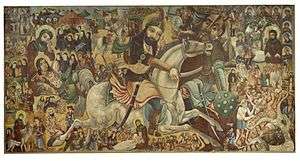Hierarchical proportion

Hierarchical proportion is a technique used in art, mostly in sculpture and painting, in which the artist uses unnatural proportion or scale to depict the relative importance of the figures in the artwork.
For example, in Egyptian times, people of higher status would sometimes be drawn or sculpted larger than those of lower status.
During the Dark Ages, people with more status had larger proportions than serfs. During the Renaissance images of the human body began to change proportion was used to depict the reality an artist interpreted.
Gallery
-
The Narmer Palette - obverse side, Early Dynastic Period of Egypt, about the 31st century BC
-

Victory stele of Naram Sin, the Akkadian Empire in ancient Mesopotamia, 2350 - 2000 BC
-

The Weighing of the Heart from the Book of the Dead of Ani, 19th dynasty of the New Kingdom of ancient Egypt, c. 1250 B.C.
-

Panel 3 from Maya city Cancuén portraying the ruler Tajal Chan Ahk, 8th-century
-

Otto III from the Gospels of Otto III, Reichenau Abbey in southern Germany, late 10th or early 11th century
-

Last Judgement by Gislebertus in the west tympanum of the Autun Cathedral in France, 1120 - 1146.
-

Maestà of Duccio, Siena, Italy, 1308 – 1311
-

Portinari Altarpiece, Flemish painter Hugo van der Goes for the church of the hospital of Santa Maria Nuova in Florence in Italy, c. 1475.
-

Battle of Karbala, Imam Husayn’s half brother Abbas Al-Musavi in focus, Isfahan, Iran, late 19th - early 20th century [2]
- ^ Cite error: The named reference
Hamzanamawas invoked but never defined (see the help page). - ^ Cite error: The named reference
BrooklynMuseumKarbalawas invoked but never defined (see the help page).
References
- Artforms by Preble, Preble, Frank; Prentice Hall 2004
<div class="reflist columns references-column-width" style="-moz-column-width: refs
[3]; -webkit-column-width: refs
[3]; column-width: refs
[3]; list-style-type: decimal;">
- 1 2 3 4 "British Museum - Nebamun hunting in the marshes, fragment of a scene from the tomb-chapel of Nebamun". London: British Museum. Retrieved 7 July 2013.
- 1 2 3 "Brooklyn Museum: Arts of the Islamic World: Battle of Karbala". Brooklyn, New York: Brooklyn Museum. Retrieved 7 July 2013.
- 1 2 3 "The adventures of Hamza". Washington, D.C.: Smithsonian Institution. Retrieved 7 July 2013.
External links
- 'Gifts for the Gods: Images from Egyptian Temples, a fully digitized exhibition catalog from The Metropolitan Museum of Art Libraries, which contains material on hierarchical proportion
